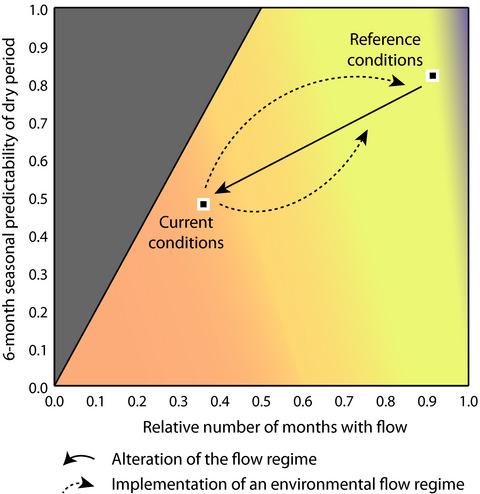当前位置:
X-MOL 学术
›
J. Appl. Ecol.
›
论文详情
Our official English website, www.x-mol.net, welcomes your
feedback! (Note: you will need to create a separate account there.)
Accounting for flow intermittency in environmental flows design
Journal of Applied Ecology ( IF 5.0 ) Pub Date : 2020-04-01 , DOI: 10.1111/1365-2664.13590 Vicenç Acuña 1, 2 , Dídac Jorda‐Capdevila 1, 2 , Paolo Vezza 3 , Anna Maria De Girolamo 4 , Michael E. McClain 5, 6 , Rachel Stubbington 7 , Amandine V. Pastor 8 , Nicolas Lamouroux 9 , Daniel Schiller 10 , Antoni Munné 11 , Thibault Datry 9
Journal of Applied Ecology ( IF 5.0 ) Pub Date : 2020-04-01 , DOI: 10.1111/1365-2664.13590 Vicenç Acuña 1, 2 , Dídac Jorda‐Capdevila 1, 2 , Paolo Vezza 3 , Anna Maria De Girolamo 4 , Michael E. McClain 5, 6 , Rachel Stubbington 7 , Amandine V. Pastor 8 , Nicolas Lamouroux 9 , Daniel Schiller 10 , Antoni Munné 11 , Thibault Datry 9
Affiliation

|
1. River ecosystems worldwide are affected by altered flow regimes, and an advanced science and practice of environmental flows has developed to understand and reduce these impacts. But most environmental flows approaches ignore flow intermittency, which is a natural feature of 30% of the global river network length. Ignoring flow intermittency when setting environmental flows in naturally intermittent rivers might lead to deleterious ecological effects. 2. We review evidence of the ecological effects of flow intermittency and provide guidance to incorporate intermittency (non-flow events) into existing methods judged as suitable for application in temporary waterways. 3. To better integrate non-flow events into hydrological methods, we propose a suite of new indicators to be used in the Range of Variability Approach. These indicators reflect dry periods and the unpredictable nature of temporary waterways. We develop a predictability index for protecting those species adapted to temporary conditions. 4. For hydraulic habitat models, we find that mesohabitat methods are particularly effective for describing complex habitat dynamics during dry phases. We present an example of the European eel to show the relationship between discharge and non-flow days and wet area, habitat suitability, and connectivity. 5. We find that existing holistic approaches may be applied to temporary waterways without significant structural alteration to their stepwise frameworks, but new component methods are needed to address flow-related aspects across both flow and non-flow periods of the flow regime. 6. Synthesis and applications. Setting environmental flow requirements for temporary waterways requires modification and enhancement of existing approaches and methodologies, most notably the explicit consideration of non‐flow events and greater integration of specific geomorphic, hydrogeologic, and hydraulic elements. Temporary waterways are among the freshwater ecosystems most vulnerable to alterations in flow regimes, and they are also under great pressure. The methodological modifications recommended in this paper will aid water managers in protecting key components of temporary flow regimes, thereby preserving their unique ecology and associated services.
中文翻译:

考虑环境流量设计中的流量间歇性
1. 世界范围内的河流生态系统受到水流状态改变的影响,并且已经发展出先进的环境流向科学和实践来了解和减少这些影响。但大多数环境流量方法都忽略了流量间歇性,这是全球河网长度 30% 的自然特征。在自然间歇性河流中设置环境流量时忽略流量间歇性可能会导致有害的生态影响。2. 我们审查流动间歇性生态效应的证据,并提供指导以将间歇性(非流动事件)纳入被判断为适用于临时水道的现有方法。3. 为了更好地将非流量事件整合到水文方法中,我们提出了一套新指标,用于变异范围法。这些指标反映了干旱期和临时水道的不可预测性。我们开发了一个可预测性指数,以保护那些适应临时条件的物种。4. 对于水力栖息地模型,我们发现中型栖息地方法对于描述干旱阶段复杂的栖息地动态特别有效。我们提供了一个欧洲鳗鱼的例子,以展示排放和非流动天数与潮湿面积、栖息地适宜性和连通性之间的关系。5. 我们发现现有的整体方法可以应用于临时水道,而不会对其逐步框架进行重大的结构改变,但是需要新的组件方法来解决流态的流动和非流动时期与流动相关的方面。6. 合成与应用。为临时水道设置环境流量要求需要修改和增强现有的方法和方法,最显着的是明确考虑非流量事件以及特定地貌、水文地质和水力要素的更大整合。临时水道是最容易受到流态变化影响的淡水生态系统之一,它们也承受着巨大的压力。本文中推荐的方法修改将帮助水资源管理者保护临时流动状态的关键组成部分,从而保护他们独特的生态和相关服务。和液压元件。临时水道是最容易受到流态变化影响的淡水生态系统之一,它们也承受着巨大的压力。本文中推荐的方法修改将帮助水资源管理者保护临时流动状态的关键组成部分,从而保护他们独特的生态和相关服务。和液压元件。临时水道是最容易受到流态变化影响的淡水生态系统之一,它们也承受着巨大的压力。本文中推荐的方法修改将帮助水资源管理者保护临时流动状态的关键组成部分,从而保护他们独特的生态和相关服务。
更新日期:2020-04-01
中文翻译:

考虑环境流量设计中的流量间歇性
1. 世界范围内的河流生态系统受到水流状态改变的影响,并且已经发展出先进的环境流向科学和实践来了解和减少这些影响。但大多数环境流量方法都忽略了流量间歇性,这是全球河网长度 30% 的自然特征。在自然间歇性河流中设置环境流量时忽略流量间歇性可能会导致有害的生态影响。2. 我们审查流动间歇性生态效应的证据,并提供指导以将间歇性(非流动事件)纳入被判断为适用于临时水道的现有方法。3. 为了更好地将非流量事件整合到水文方法中,我们提出了一套新指标,用于变异范围法。这些指标反映了干旱期和临时水道的不可预测性。我们开发了一个可预测性指数,以保护那些适应临时条件的物种。4. 对于水力栖息地模型,我们发现中型栖息地方法对于描述干旱阶段复杂的栖息地动态特别有效。我们提供了一个欧洲鳗鱼的例子,以展示排放和非流动天数与潮湿面积、栖息地适宜性和连通性之间的关系。5. 我们发现现有的整体方法可以应用于临时水道,而不会对其逐步框架进行重大的结构改变,但是需要新的组件方法来解决流态的流动和非流动时期与流动相关的方面。6. 合成与应用。为临时水道设置环境流量要求需要修改和增强现有的方法和方法,最显着的是明确考虑非流量事件以及特定地貌、水文地质和水力要素的更大整合。临时水道是最容易受到流态变化影响的淡水生态系统之一,它们也承受着巨大的压力。本文中推荐的方法修改将帮助水资源管理者保护临时流动状态的关键组成部分,从而保护他们独特的生态和相关服务。和液压元件。临时水道是最容易受到流态变化影响的淡水生态系统之一,它们也承受着巨大的压力。本文中推荐的方法修改将帮助水资源管理者保护临时流动状态的关键组成部分,从而保护他们独特的生态和相关服务。和液压元件。临时水道是最容易受到流态变化影响的淡水生态系统之一,它们也承受着巨大的压力。本文中推荐的方法修改将帮助水资源管理者保护临时流动状态的关键组成部分,从而保护他们独特的生态和相关服务。









































 京公网安备 11010802027423号
京公网安备 11010802027423号